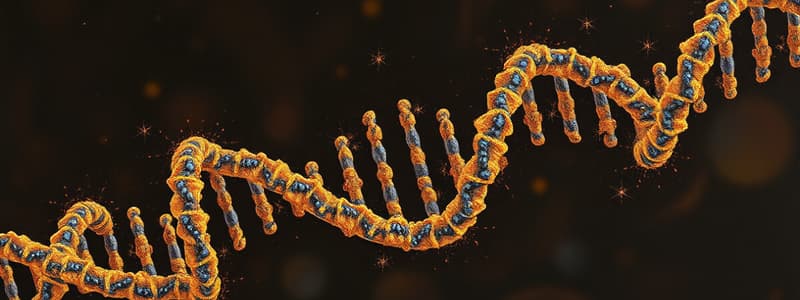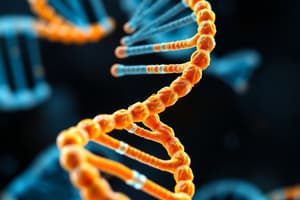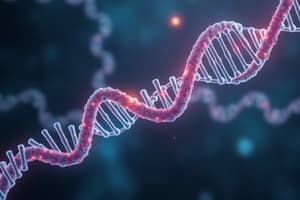Podcast
Questions and Answers
What is the sugar in DNA?
What is the sugar in DNA?
deoxyribose
What is the sugar in RNA?
What is the sugar in RNA?
ribose
How many strands does DNA have?
How many strands does DNA have?
2 strands
How many strands does RNA have?
How many strands does RNA have?
What is the base for DNA?
What is the base for DNA?
What is the base for RNA?
What is the base for RNA?
What is the process of using DNA to produce complementary RNA molecules?
What is the process of using DNA to produce complementary RNA molecules?
What sequence in mRNA complements the sequence in the DNA template?
What sequence in mRNA complements the sequence in the DNA template?
In eukaryotes, where is RNA formed and where does it travel?
In eukaryotes, where is RNA formed and where does it travel?
What binds DNA during transcription?
What binds DNA during transcription?
What is a polypeptide?
What is a polypeptide?
What is the genetic code?
What is the genetic code?
What is a codon?
What is a codon?
What acts like a 'start' and 'stop' signal for protein synthesis?
What acts like a 'start' and 'stop' signal for protein synthesis?
What is translation?
What is translation?
What is an anticodon?
What is an anticodon?
What is gene expression?
What is gene expression?
What are genes?
What are genes?
What is the central dogma of molecular biology?
What is the central dogma of molecular biology?
All organisms are mostly the same in?
All organisms are mostly the same in?
What bonds hold the bases of DNA molecules together?
What bonds hold the bases of DNA molecules together?
Which two scientists are credited with discovering the structure of DNA?
Which two scientists are credited with discovering the structure of DNA?
What is the 1st step of DNA replication?
What is the 1st step of DNA replication?
What is the 2nd step of DNA replication?
What is the 2nd step of DNA replication?
What is the 3rd step of DNA replication?
What is the 3rd step of DNA replication?
If a DNA molecule is composed of 40% thymine, what percentage of guanine is expected?
If a DNA molecule is composed of 40% thymine, what percentage of guanine is expected?
What does DNA replication result in?
What does DNA replication result in?
What adds complementary bases during replication?
What adds complementary bases during replication?
What is the spiral structure of DNA described as?
What is the spiral structure of DNA described as?
DNA is found in what part of the cell?
DNA is found in what part of the cell?
What pairs with thymine?
What pairs with thymine?
What pairs with guanine?
What pairs with guanine?
During what phase of a cell's cycle does replication take place?
During what phase of a cell's cycle does replication take place?
What is the purpose of DNA?
What is the purpose of DNA?
What is the purpose of RNA?
What is the purpose of RNA?
What does RNA stand for?
What does RNA stand for?
The actions of your traits or what your traits are made up of is?
The actions of your traits or what your traits are made up of is?
DNA to RNA is called?
DNA to RNA is called?
RNA into protein is called?
RNA into protein is called?
What are the 3 types of RNA?
What are the 3 types of RNA?
What carries instructions to make a protein?
What carries instructions to make a protein?
Where are ribosome proteins made?
Where are ribosome proteins made?
What carries the amino acid to the ribosomes and matches them to the mRNA code?
What carries the amino acid to the ribosomes and matches them to the mRNA code?
What does one of the DNA strands serve as when making RNA?
What does one of the DNA strands serve as when making RNA?
Flashcards are hidden until you start studying
Study Notes
DNA and RNA Structure
- DNA contains deoxyribose sugar; RNA contains ribose sugar.
- DNA is a double-stranded molecule; RNA is single-stranded.
- DNA bases: Adenine (A), Thymine (T), Guanine (G), Cytosine (C).
- RNA bases: Adenine (A), Uracil (U), Guanine (G), Cytosine (C).
Transcription and Translation
- Transcription is the process of synthesizing RNA from a DNA template.
- mRNA sequence complements the DNA template through base pairing.
- Translation decodes mRNA into a protein using codons (three-base sequences).
- Codons act like "start" and "stop" signals in protein synthesis.
- Anticodons on tRNA molecules pair with mRNA codons.
Gene Expression and Genetic Code
- Gene expression involves DNA, RNA, and proteins to manifest genetic information.
- Genes provide instructions for protein assembly.
- Genetic code consists of four DNA nitrogen bases structured in sequences across chromosomes.
Molecular Biology Principles
- Central dogma: Information flows from DNA to RNA to protein.
- All organisms share common molecular biology features in their genes.
- Hydrogen bonds hold DNA bases together.
DNA Replication
- First step: DNA "unzips" to begin replication.
- Second step: Complementary bases attach to the template strands.
- Final result: Two identical DNA molecules, each containing an original strand.
- DNA polymerase adds complementary bases during replication.
- Replication occurs in the "S" phase of the cell cycle.
Components of RNA
- Three types of RNA:
- Messenger RNA (mRNA) carries protein synthesis instructions.
- Ribosomal RNA (rRNA) makes up ribosome structures where proteins are synthesized.
- Transfer RNA (tRNA) brings amino acids to the ribosomes.
Key DNA and RNA Pairing Rules
- Thymine pairs with Adenine; Guanine pairs with Cytosine.
- In DNA, if thymine constitutes 40%, guanine should be 10%, following Chargaff's rules.
Location of Genetic Material
- DNA is typically located in the nucleus of a cell.
- RNA is formed in the nucleus and travels to the cytoplasm for protein synthesis.
Functions of DNA and RNA
- DNA's primary role: Store and transmit genetic information.
- RNA's main function: Synthesize proteins based on genetic instructions.
Studying That Suits You
Use AI to generate personalized quizzes and flashcards to suit your learning preferences.





